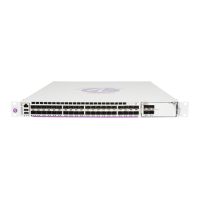Configuring IP Router Parameters
38 7705 SAR OS Router Configuration Guide
Static Routes, Dynamic Routes, and ECMP
Static routes to next-hop addresses are supported on the 7705 SAR. Dynamic routing using
the OSPF, RIP, IS-IS, or BGP protocols is also supported.
If the 7705 SAR chassis is equipped with two CSMs (Control and Switching modules) for
redundancy, non-stop services are supported. Therefore, if the active CSM experiences an
activity switch, all static route entries are maintained.
ECMP (Equal-Cost Multipath Protocol) refers to the distribution of packets over two or more
outgoing links that share the same routing cost. The 7705 SAR load-balances traffic over
multiple equal-cost links with a hashing algorithm that uses header fields from incoming
packets to calculate which link to use. By adding additional fields to the algorithm, you can
increase the randomness of the results and ensure a more even distribution of packets across
available links. ECMP is supported on static routes and dynamic (OSPF, IS-IS, and BGP)
routes. The 7705 SAR supports ECMP for LDP and IP traffic.
ECMP for LDP can be used to distribute MPLS traffic across the links in order to balance the
traffic load for spoke SDPs. If ECMP for LDP is enabled and there is more than one
pseudowire service configured, load balancing will take place on a per-pseudowire basis.
ECMP for LDP will load-balance traffic across all equal-cost links on a per-service basis.
VPRN traffic is processed again with the same set of hashing attributes to ensure per-flow
load balancing across multiple equal-cost LDP links. For more information on ECMP for
LDP, refer to the 7705 SAR OS MPLS Guide, “Label Distribution Protocol”.
Router advertisement Sent by a router to advertise its presence as well as
link and Internet parameters, periodically or in
response to a router solicitation message
Neighbor solicitation Sent by a node to determine the link-layer address
of a neighbor or to verify that a neighbor is still
reachable
Neighbor advertisement Sent by a node in response to a neighbor
solicitation message
Nodes can also send unsolicited neighbor
advertisements to announce a link-layer address
change
Table 4: ICMPv6 Capabilities for IPv6 (Continued)
ICMPv6 Message Description

